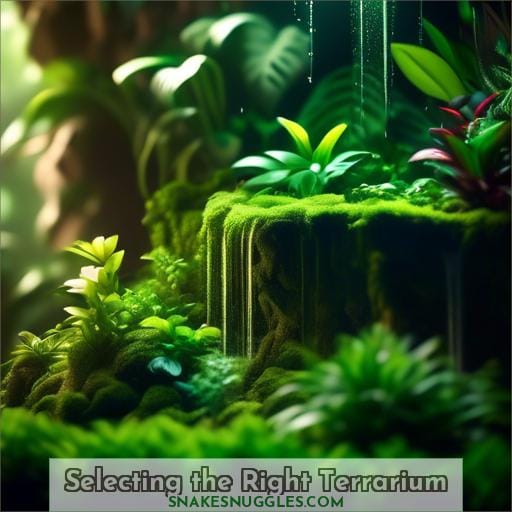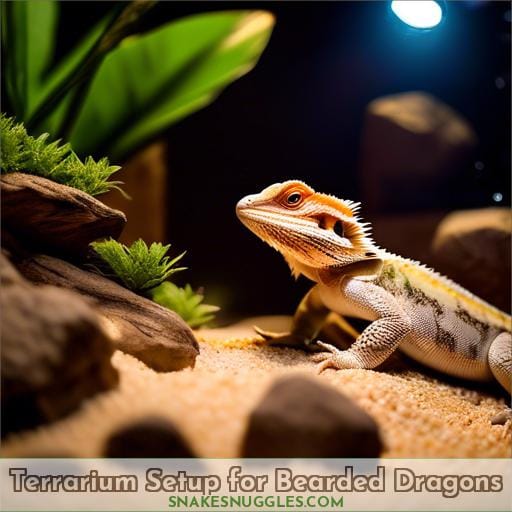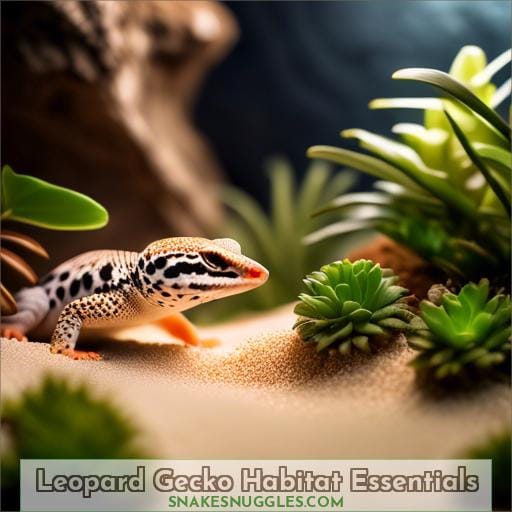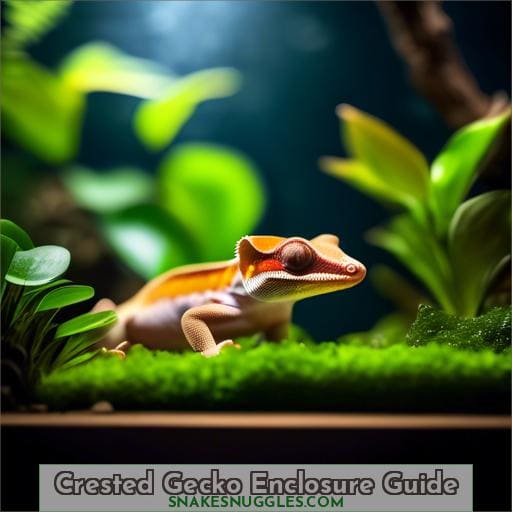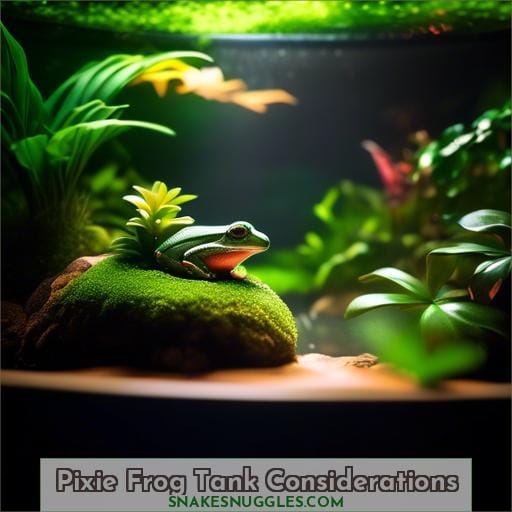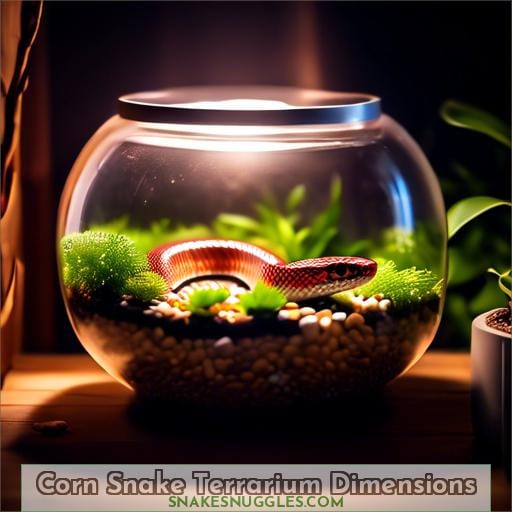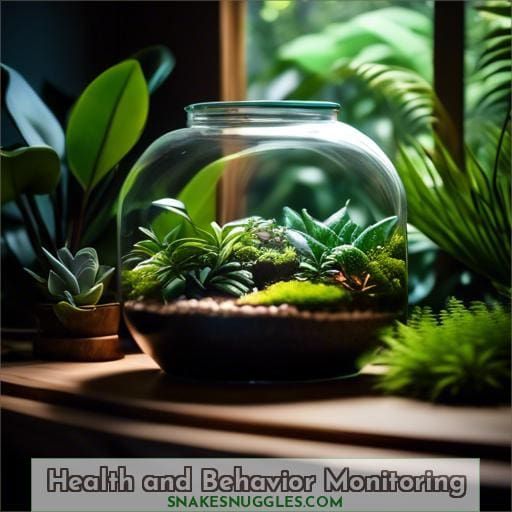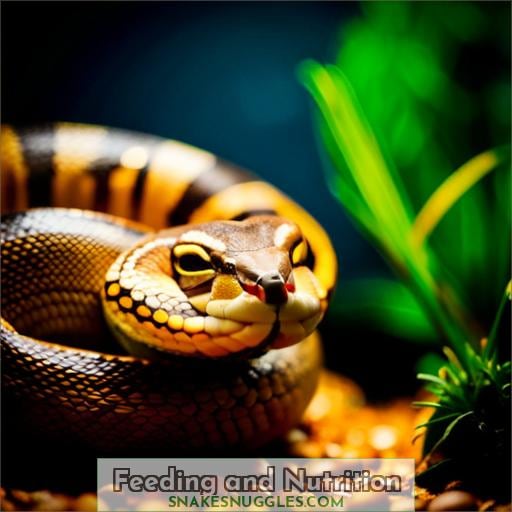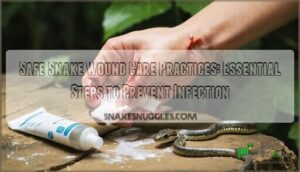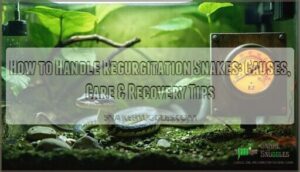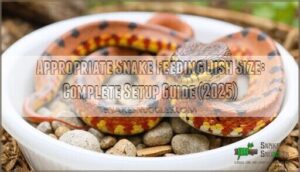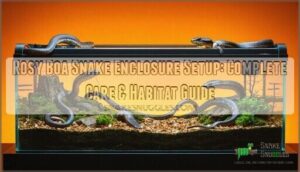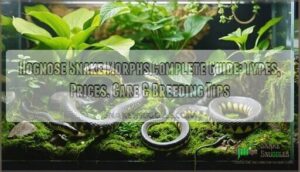This site is supported by our readers. We may earn a commission, at no cost to you, if you purchase through links.
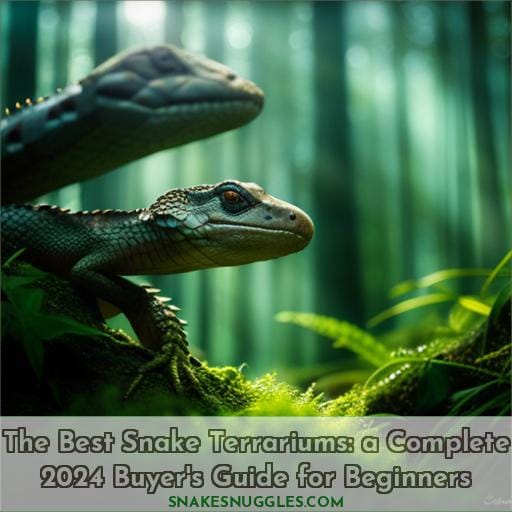 Embarking on the journey of creating the perfect home for your slithery companion can feel like navigating a labyrinth. Fear not! This essential buyer’s guide and tips for terrariums for snakes will illuminate the path to a sanctuary that not only meets the unique needs of your snake but also fosters a sense of freedom, belonging, and safety.
Embarking on the journey of creating the perfect home for your slithery companion can feel like navigating a labyrinth. Fear not! This essential buyer’s guide and tips for terrariums for snakes will illuminate the path to a sanctuary that not only meets the unique needs of your snake but also fosters a sense of freedom, belonging, and safety.
From understanding the vast universe of size requirements to selecting the ideal shape and function, we’ll guide you through every twist and turn. Whether you’re a seasoned herpetologist or a curious newcomer, prepare to unlock the secrets to a thriving habitat where your snake can explore, rest, and simply be.
Table Of Contents
- Key Takeaways
- Selecting the Right Terrarium
- Terrarium Setup for Bearded Dragons
- Leopard Gecko Habitat Essentials
- Crested Gecko Enclosure Guide
- Pixie Frog Tank Considerations
- Corn Snake Terrarium Dimensions
- Health and Behavior Monitoring
- Feeding and Nutrition
- Frequently Asked Questions (FAQs)
- How can I ensure the safety of my snake if I have other pets in the house?
- What are the best practices for maintaining hygiene in the snake terrarium without disturbing my snake too often?
- Can I use live plants in my snake’s terrarium, and if so, which plants are safe and require minimal sunlight?
- How can I provide mental stimulation for my snake within its terrarium?
- What are some emergency measures I should be aware of if my snake escapes its terrarium?
- Conclusion
Key Takeaways
- Select a terrarium that can accommodate the snake’s current size and allow for growth, ensuring ample space for movement, hiding, and displaying natural behaviors.
- Choose a secure and easy-to-maintain design that provides control over temperature and humidity, using durable materials for the safety and longevity of the habitat.
- Ensure the terrarium has proper ventilation to maintain a healthy environment for the snake.
- Consider the shape and function of the terrarium, prioritizing space for the snake to exhibit behaviors like climbing or burrowing, while also taking into account the aesthetics and functionality of the enclosure.
Selecting the Right Terrarium
When selecting the right terrarium for your snake, it’s crucial to understand the size requirements and ensure the shape and function of the habitat align with your pet’s needs.
You’ll want a terrarium that provides ample space for your snake to move, hide, and exhibit natural behaviors.
It’s also essential to choose a design that’s secure, easy to maintain, and equipped with the necessary features for temperature and humidity control.
Understanding Size Requirements
When selecting the right terrarium for your snake, it’s crucial to consider both the current and future size of your pet to ensure they’ve ample space to thrive.
- Size Flexibility: Start with a minimum corn snake enclosure size that allows for growth accommodations.
- Spatial Considerations: Factor in dimensional adaptations for terrarium decorations.
- Developmental Adjustments: Upgrade as your snake matures.
- Environmental Enrichment: Ensure space for exploration and comfort.
Terrarium Shape and Function
In selecting the right terrarium for your snake, you’ll need to consider both its size and function, ensuring it’s not only large enough for your pet to stretch out in but also conducive to its natural behaviors.
Terrarium shapes vary, from rectangular to more unique designs, each offering different benefits.
Aesthetics matter, but functionality is key. Opt for a design that maximizes space and supports your snake’s natural habits, including climbing or burrowing.
Durability of materials is crucial for longevity and safety, while proper ventilation ensures a healthy environment within the snake habitat. Whether it’s a corn snake cage or a general reptile tank, selecting the right dimensions and features will create a thriving space for your pet.
Terrarium Setup for Bearded Dragons
When setting up a terrarium for your bearded dragon, it’s crucial to focus on the right tank size, enrichment, and accessories to ensure a healthy and stimulating environment.
You’ll need to select a tank that provides ample space for exploration and exercise. The appropriate heating and lighting are essential to mimic their natural habitat.
Incorporating enrichment items like climbing structures and hiding spots will keep your bearded dragon engaged and happy.
Appropriate Tank Sizes
A bearded dragon’s tank size is crucial for its health and happiness, and you’ll need to choose one that accommodates its growth stages.
For a thriving habitat, start with a 20-gallon tank for juveniles, but as they grow, a 40-gallon becomes necessary.
Adult bearded dragons, especially large ones, may require tanks up to 120 gallons to ensure ample space for movement and enrichment.
This scaling of enclosure sizes reflects a deep understanding of reptile husbandry experts, emphasizing the importance of space adaptation to support the dragon’s well-being.
Adequate tank size evolution, considering size vs species and growth considerations, is essential for creating a suitable environment that mirrors a corn snake habitat‘s dimensions, ensuring your bearded dragon enjoys a sense of freedom and safety.
Enrichment and Accessories
Enrichment accessories, such as puzzle feeders and climbing structures, are essential for stimulating your bearded dragon’s mind and encouraging natural behaviors. These items not only keep your pet engaged but also mimic the environmental variety they’d experience in the wild, promoting a healthier and more active lifestyle.
Here are four key items to consider for your bearded dragon’s terrarium:
- Climbing Structures: Offer platforms and branches for climbing, enhancing their physical activity and providing a vantage point for basking.
- Puzzle Feeders: Introduce puzzle feeders to stimulate their problem-solving skills, making mealtime both fun and rewarding.
- Rotating Accessories: Regularly change the layout and the enrichment items in the terrarium to prevent boredom and maintain behavioral engagement.
- Hides and Shelters: Provide various hides and shelters for security and privacy, crucial for your bearded dragon’s sense of safety and well-being.
Incorporating these elements into your bearded dragon’s environment not only caters to their physical needs but also supports their mental health, ensuring a happy and content pet.
Leopard Gecko Habitat Essentials
When setting up a habitat for your leopard gecko, it’s crucial to get the tank size and layout right, as well as the substrate and temperature control.
You’ll want a horizontal tank that’s at least 20 gallons for ample floor space, with a substrate that mimics their natural environment and supports their health. Proper temperature gradients are essential for their well-being, so invest in reliable heating and monitoring equipment to maintain the ideal range.
Tank Size and Layout
Moving on from bearded dragons, let’s dive into setting up the perfect home for leopard geckos, focusing on tank size and layout essentials. When it comes to your leopard gecko’s habitat, size adaptation and layout flexibility are key.
A 10-15 gallon horizontal tank is ideal for one or two geckos, providing ample space for exploration and comfort. Avoid tall tanks, as these creatures are ground-dwellers and require horizontal space to thrive.
Here’s a quick reference table for tank customization and decorative arrangements:
| Tank Size (Gallons) | Dimensions (LxWxH) |
|---|---|
| 10 | 20 x 10 x 12 |
| 15 | 24 x 12 x 12 |
| 20 | 30 x 12 x 12 |
Substrate and Temperature Control
When setting up a habitat for your leopard gecko, it’s crucial to select a substrate that won’t pose a risk of impaction and to establish a temperature gradient that mimics their natural environment.
- Substrate variety: Experiment with safe options like reptile carpet or tile, avoiding sand which can cause impaction.
- Temperature gradients: Use under-tank heaters and basking lamps to create warm and cool zones.
- Humidity levels: Monitor with a hygrometer and adjust using misting or a humid hide.
Crested Gecko Enclosure Guide
When setting up a terrarium for your crested gecko, it’s crucial to focus on vertical space, as these arboreal reptiles love to climb and explore at different heights.
Ensure the enclosure maintains humidity levels between 60-80% to mimic their natural habitat and promote healthy shedding.
Incorporating climbing structures like branches and plants not only enriches their environment but also supports their instinctual behaviors.
Vertical Space Utilization
In accordance with your needs for a crested gecko enclosure, it’s crucial to focus on vertical space beyond mere floor area, as these arboreal reptiles thrive in environments that allow them to climb and explore above ground level.
Maximizing vertical space is key, and incorporating climbing accessories can create a stimulating arboreal habitat.
| Feature | Benefit |
|---|---|
| Branch placement | Encourages natural climbing |
| Elevated hideouts | Provides security and comfort |
| Climbing accessories | Enhances exploration |
| Vertical dimensions | Mimics natural arboreal setting |
Humidity and Climbing Structures
You’ll need to maintain the right balance of humidity and provide various climbing structures to mimic the natural environment of crested geckos. Humidity management is crucial; aim for levels between 60-80% at night, allowing it to drop to 45-50% during the day.
Incorporate climbing accessories like branches and elevated hideouts for vertical exploration, enhancing their physical and mental well-being.
Moisture control is key; too much humidity can lead to health issues, so ensure proper ventilation and use tools like digital hygrometers for accurate monitoring. This approach not only caters to their physiological needs but also fosters a sense of belonging and safety within their habitat.
Pixie Frog Tank Considerations
When setting up a terrarium for your pixie frog, it’s crucial to prioritize horizontal space and maintain the right humidity levels. You’ll want to provide a substantial water feature and select a substrate that supports these conditions.
Horizontal Space and Humidity
While setting up a tank for your pixie frog, it’s crucial to prioritize horizontal space and maintain high humidity levels to mimic their natural habitat.
- Horizontal space: Ensure ample room for movement and enrichment activities.
- Humidity balance: Use a substrate that retains moisture and mist regularly.
- Ventilation needs: Install a secure lid that allows airflow while keeping humidity consistent.
Water Features and Substrate
Continuing from the importance of horizontal space and humidity for pixie frogs, it’s essential to also focus on their aquatic needs and substrate preferences. They thrive in an environment that mimics their natural habitat, which includes a moisture-retentive substrate and a water feature large enough for them to submerge at least up to their chin.
Opt for an aquatic substrate like mud or moss bedding, which maintains the necessary moisture levels. Incorporate pond features or a small waterfall for enrichment, enhancing your pet’s space and catering to their solitary nature.
Corn Snake Terrarium Dimensions
When setting up a terrarium for your corn snake, it’s crucial to prioritize both comfort and security, especially for hatchlings.
You’ll want to ensure the enclosure is spacious enough for your snake to stretch out fully and explore, with a minimum recommended size of 48L x 24W x 24H for adults to accommodate their climbing habits.
For hatchlings, starting with a smaller, secure enclosure filled with hiding spots can help them feel safe. But remember, as they grow, upgrading to a larger space is necessary to support their well-being and natural behaviors.
Minimum Size for Comfort
After ensuring your pixie frog has the right horizontal space and humidity in its tank, let’s turn our attention to the corn snake, a popular pet that requires a carefully sized terrarium to thrive. For your corn snake, you’ll want to start with a minimum terrarium size of 48 inches in length, 24 inches in width, and 24 inches in height, which provides ample room for them to stretch, climb, and explore.
- Comfortable Dimensions: Ensure the terrarium’s size supports your snake’s natural behaviors and growth.
- Adequate Space: A spacious terrarium allows for essential enrichment items, like hides and climbing branches.
- Optimal Enclosure: Proper dimensions facilitate a suitable habitat that mimics their natural environment.
- Suitable Habitat: A well-sized enclosure ensures your corn snake feels secure, promoting overall well-being.
Enclosure Security for Hatchlings
Given the importance of a secure environment for hatchling corn snakes, you’ll need to ensure their enclosure is escape-proof, as these tiny serpents are adept at finding ways out. Hatchling safety is paramount, so choose secure enclosures with fine mesh or solid walls and a tightly fitting lid.
Escape prevention is critical; look for tanks with lock mechanisms or invest in cage door locks. For added hatchling security, avoid gaps and ensure all potential escape routes are sealed.
Health and Behavior Monitoring
When setting up a terrarium for your snake, it’s crucial to keep an eye on their health and behavior as these can be key indicators of their well-being. You’ll want to recognize the normal activities of your snake, such as shedding cycles, eating habits, and general movement within their habitat.
Equally important is identifying signs of distress or illness, which may manifest as changes in these behaviors, refusal to eat, problems with shedding, or unusual hiding. This awareness will ensure you can provide the best care and intervene promptly if issues arise.
Identifying Common Behaviors
You’ll need to recognize several key behaviors to effectively monitor your snake’s health and well-being.
Watch for behavioral cues like reduced activity or refusal to eat, which may signal distress.
Handling techniques should be gentle to foster trust.
Environmental adjustments, like tweaking temperature or humidity, can improve comfort.
Social interactions should be minimal; snakes are solitary.
Offer psychological enrichment with habitat changes to prevent boredom.
Recognizing Signs of Illness
Monitor your snake’s health by observing its behavior and physical condition. Signs of illness may include changes in activity levels, appetite, or appearance.
Watch for temperature fluctuations and respiratory issues like wheezing or mucus.
Look for skin abnormalities such as lesions or shedding irregularities.
Be aware of digestive problems indicated by regurgitation.
Notice sudden behavioral changes.
These symptoms warrant a prompt visit to your vet.
Feeding and Nutrition
When setting up a terrarium for your snake, it’s crucial to consider their dietary needs to ensure they thrive. For corn snakes, a diet primarily consisting of rodents like mice is essential, as they’re obligate carnivores requiring whole prey.
It’s safest to feed them humanely killed, frozen mice, which should be thawed properly before offering them to your snake.
Diet Varieties for Corn Snakes
In terms of diet, corn snakes primarily thrive on a carnivorous diet, focusing on whole prey items like mice and rats, which closely mimic their natural feeding habits.
Variety options and nutritional balance are key, with feeding schedules tailored to their age and size.
Prey preferences may vary, and dietary supplements can ensure a well-rounded diet, enhancing your snake’s health and vitality.
Safe Feeding Practices
A snake’s feeding routine is crucial for its health, so it’s important you’re aware of the safest practices to ensure your pet thrives.
- Establish a consistent feeding schedule to provide stability and prevent overfeeding.
- Use tongs for prey handling to protect both you and your snake.
- Offer a feeder variety, including dietary supplements, to mimic natural diet diversity.
- Ensure rodent safety by sourcing from reputable suppliers.
Frequently Asked Questions (FAQs)
How can I ensure the safety of my snake if I have other pets in the house?
To safeguard your snake with other pets around, secure its terrarium with a lock.
Keep it in a separate room, ensuring no unsupervised interactions occur.
What are the best practices for maintaining hygiene in the snake terrarium without disturbing my snake too often?
Ah, the art of maintaining a pristine snake terrarium without becoming a constant presence in your slithery friend’s home. Here’s the scoop: spot clean daily to remove waste and uneaten food, ensuring your snake’s pad doesn’t turn into a no-go zone.
Weekly, dive in for a deeper clean—replace the substrate, wash the water bowl with hot water and unscented soap, and sanitize decor.
Can I use live plants in my snake’s terrarium, and if so, which plants are safe and require minimal sunlight?
You can indeed use live plants in your snake’s terrarium.
Snake plants, pothos, and spider plants are safe options that thrive with minimal sunlight.
How can I provide mental stimulation for my snake within its terrarium?
To spark your snake’s curiosity, juxtapose a maze with its usual straight paths, challenging it to slither and explore.
Rotate hides and climbing structures, offering fresh landscapes that satisfy its instinctual needs for security and adventure.
What are some emergency measures I should be aware of if my snake escapes its terrarium?
If your snake escapes, immediately search warm spots and along walls.
Secure pets, as they pose risks.
Use flour across doorways to track movement.
Keep the terrarium open; some return on their own.
Act quickly; the longer it’s out, the harder it’s to find.
Conclusion
Just as a knight completes a quest, you’ve navigated the terrarium terrain, arming yourself with the knowledge to create a haven for your scaly companion. Your journey through this buyer’s guide to terrariums for snakes has equipped you with the essentials.
Now it’s time to craft a world where your snake thrives. Remember, a well-planned habitat is key to your pet’s health and happiness.
Forge ahead, confident in your choices, and watch your serpent flourish.

